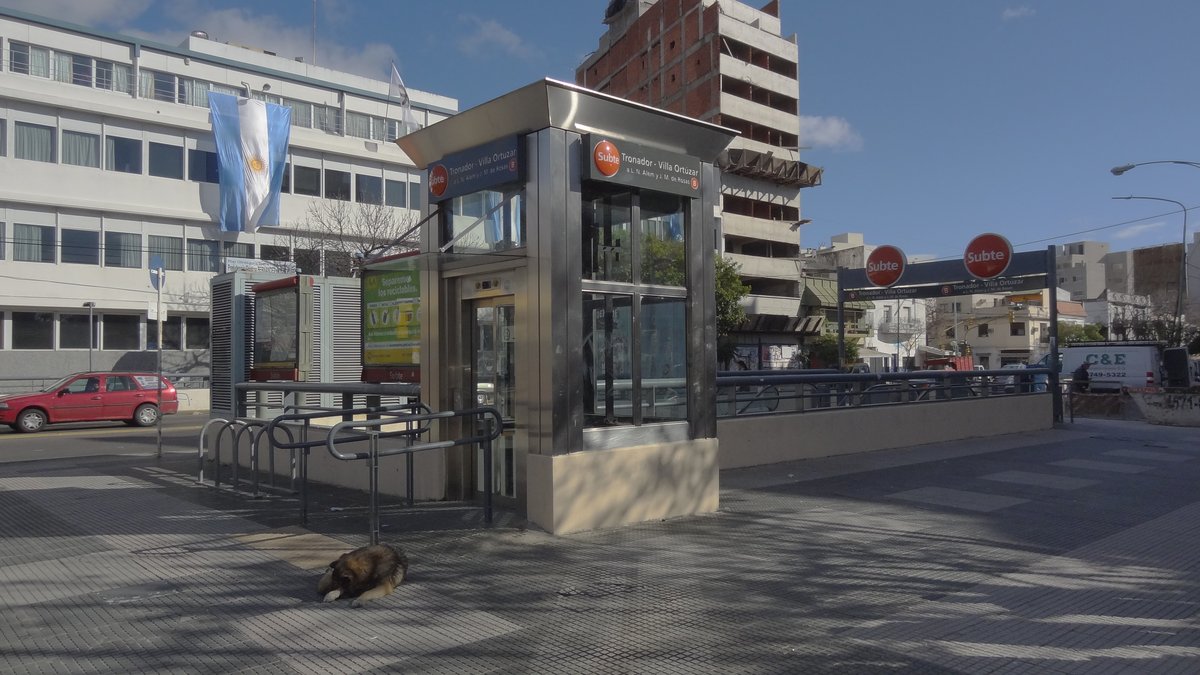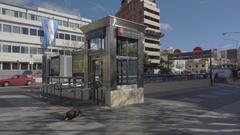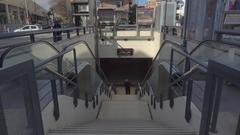
Tronador Visiting Hours, Tickets, and Villa Ortúzar Buenos Aires Historical Sites Guide
Date: 15/06/2025
Introduction to Tronador and Villa Ortúzar, Buenos Aires
Villa Ortúzar is a tranquil, historically rich neighborhood in the northwest of Buenos Aires. Founded in 1862 by Santiago Francisco de Ortúzar y Mendiola, this barrio combines leafy residential streets, historic landmarks, and a thriving cultural scene, reflecting the broader evolution of Buenos Aires itself (buenosaires.gob.ar). From its rural beginnings, participation in the city’s defense during the First British Invasion, and subsequent industrial boom, Villa Ortúzar has continually reinvented itself. Today, it is celebrated for its independent publishing houses, literary cafés, and accessible transit via the Tronador – Villa Ortúzar subway station, whose artistic stained-glass panels narrate the local story (es.wikipedia.org). This guide presents a comprehensive overview of Villa Ortúzar’s history, culture, visitor information, and travel tips.
Table of Contents
- Early Origins and Founding
- Industrialization and Urban Growth
- Demographics and Urban Character
- Cultural and Social Life
- Tronador – Villa Ortúzar Subway Station
- Visitor Information: Hours, Tickets & Accessibility
- Getting There & Transportation
- Key Attractions & Nearby Sights
- Historical Landmarks & Community Spaces
- Photographic Highlights
- Frequently Asked Questions (FAQ)
- Conclusion
- References and Further Reading
Early Origins and Founding
Villa Ortúzar’s history is deeply entwined with the early development of Buenos Aires. Originally part of “Chacarita de los Colegiales,” the area played a role in the defense during the First British Invasion of 1806 (buenosaires.gob.ar). In 1862, Santiago Francisco de Ortúzar y Mendiola purchased land from Santiago Muguerza, subdivided it, planted eucalyptus and ombú trees, and established the layout that defines the neighborhood today. His philanthropic legacy includes donating land for the General Acha School in 1888, a gesture that cemented his name in the city (buenosaires.gob.ar).
Industrialization and Urban Growth
The early 20th century saw Villa Ortúzar transform into an industrial hub. Factories such as Sudamtex (textiles), Griet (perfume), Everton (pens), and Pindapoy (juices) established the area as a working-class stronghold (infobae.com). Local bars like Bar Oriente became important social centers for workers and residents alike. Despite industrialization, the neighborhood preserved its low-rise, residential character, distinguishing itself from busier districts.
Demographics and Urban Character
Covering 1.8 km², Villa Ortúzar is among the smallest and least densely populated neighborhoods in the city, with a 2001 population of 21,256 (buenosaires.gob.ar). Its boundaries are marked by major avenues and the General Urquiza railway. The area is characterized by peaceful, tree-lined streets, well-maintained facades, and a notable absence of high-rise buildings, making it a desirable location for those seeking tranquility within Buenos Aires (buenosairesconnect.com).
Cultural and Social Life
Villa Ortúzar has recently experienced a cultural revival. Independent publishers such as Ediciones Godot and Pequeño Editor, along with venues like Naesqui (a café-bookstore and community hub), have contributed to a vibrant literary and creative scene (pagina12.com.ar). The neighborhood’s authenticity and strong community bonds attract visitors seeking a genuine Buenos Aires experience.
Tronador – Villa Ortúzar Subway Station
Opened in 2003, the Tronador – Villa Ortúzar station on Line B connects the barrio to the city center and neighboring districts. Its accessible design includes ramps, elevators, Braille signage, and public restrooms. Notably, the station’s stained-glass panels by Roberto José Soler illustrate Villa Ortúzar’s rich history (es.wikipedia.org; subte.ar). Named after Cerro Tronador, the station is a modern gateway to the barrio’s heritage.
Visitor Information: Hours, Tickets & Accessibility
- Neighborhood Access: Villa Ortúzar is open to visitors at all times; there are no entry fees.
- Parks & Plazas: Public spaces like Plaza 25 de Agosto are open daily from early morning to sunset.
- Cafés & Cultural Venues: Typically open 9:00 AM–8:00 PM. Check specific venues for events.
- Accessibility: Most streets are pedestrian-friendly with ramps, though some older buildings and cobblestone areas may be less accessible. The Tronador – Villa Ortúzar subway station is fully accessible.
Getting There & Transportation
- Subway: Line B to Tronador – Villa Ortúzar station.
- Bus: Multiple lines connect the area to central Buenos Aires and adjacent barrios.
- Taxi/Rideshare: Widely available.
- Parking: Street parking is available but limited at peak times.
Key Attractions & Nearby Sights
- Plaza 25 de Agosto: The neighborhood’s green centerpiece, once home to Ortúzar’s dovecotes (buenosaires.gob.ar).
- Bar Oriente: A legendary café frequented by artists like Osvaldo Pugliese and Gustavo Cerati, known for its classic atmosphere (infobae.com).
- General Acha School: Founded in 1888, a symbol of the neighborhood’s educational roots.
- Avenida Álvarez Thomas: Lined with shops, bakeries, and the historic Anilinas Colibrí building.
- Parroquia San Fermín: Known for its devotion to San Expedito.
Nearby attractions include Chacarita Cemetery, Parque Centenario, and vibrant districts like Palermo and Belgrano.
Historical Landmarks & Community Spaces
- Plaza 25 de Agosto: Central green space, community events.
- Bar Oriente: Historic café with a storied past.
- General Acha School: Educational and architectural landmark.
- Industrial Heritage Sites: Ex Sudamtex, ex Papelera Buenos Aires, and Ventileta de Obras Sanitarias de la Nación.
Photographic Highlights
- Stained-glass panels at Tronador – Villa Ortúzar station.
- Leafy avenues and early 20th-century facades.
- Bar Oriente’s interior.
- Community murals and street festivals.
Frequently Asked Questions (FAQ)
Q: What are Villa Ortúzar’s visiting hours?
A: The neighborhood is open at all times; public plazas are accessible from morning to sunset. Cafés typically operate 9:00 AM–8:00 PM.
Q: Are there entrance fees?
A: No, Villa Ortúzar is a public neighborhood.
Q: Is Villa Ortúzar family-friendly?
A: Yes, with peaceful streets and parks.
Q: How do I get there by public transport?
A: Take Line B to Tronador – Villa Ortúzar station or use local buses.
Q: Are guided tours available?
A: Yes, through select agencies and cultural centers, though less frequent than in tourist hotspots.
Conclusion
Villa Ortúzar is an inviting destination for those seeking an authentic Buenos Aires experience rooted in history, culture, and community. Its evolution from rural land to industrious hub, and now to creative enclave, is visible in its streets, cafés, and cultural spaces. The neighborhood’s free access, strong local identity, and proximity to major transport routes make it ideal for exploration year-round.
For a personalized experience, download the Audiala app and consult official city resources for the latest on events and attractions. Stay connected with local culture and discover the heart of Buenos Aires in Villa Ortúzar.
References and Further Reading
- Villa Ortúzar – Buenos Aires City Government
- Cafés and Legends of Villa Ortúzar – Infobae
- Villa Ortúzar: Factories to Books – Página12
- Tronador – Villa Ortúzar (Subte de Buenos Aires) – Wikipedia
- Tronador – Villa Ortúzar Subway Station – Subte.ar
- Villa Ortúzar Map and Streets – Urbano Cotidiano
- Beautiful Neighborhoods for Strolling – Travel Pug
- Villa Ortúzar Periódico
- Colegios en Buenos Aires
- Buenos Aires Historia































































































































































